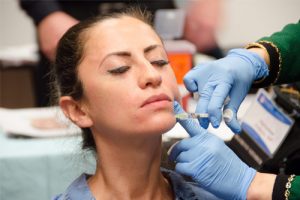The G′ Prime “Primer”
 What is G? prime?
What is G? prime?
The term G? (pronounced G prime) may not be new but it is one of today’s trending cosmetic enhancement terms that describes hyaluronic acid (HA)-based fillers’ elastic modulus. Features that differentiate the various HA fillers are particle size, the type of crosslinking agent used, the degree of crosslinking, the percentage of cross-linked HA, the amount of free (unmodified) HA present, and G? (elastic modulus). The best way to understand G? is to consider that it is a measurement of HA filler gel hardness or stiffness.
How is G prime used the by the practitioner?
Together with the cohesivity of the product, G? values are used by the clinician to determine the appropriate product choice and placement of an HA dermal facial filler to match specific patient needs and indications. Basically, the more robust and stiffer HA filler products resist force and thus have a higher G’. More fluid products have a lower G’ and disperse more in the skin.
Why is G prime important?
Understanding the different clinical characteristics and levels (high, high medium, low) can help the practitioner identify the right dermal facial filler products with the best clinical indications to fill folds, lines, wrinkles, and provide “lift” based on ease of injection, degree of tissue filling, longevity, clinical appearance, safety profile and potential side effects.
The higher G? values and higher cohesivities such as Juvéderm
™ Ultra Plus, Radiesse and Prevelle Lift, should be used in deeper lines, such as nasolabial folds and marionette lines, as well as to lift the lateral brow, to correct the nasal bridge, to give the ear lobe youthful volume, and to raise the nasal tip. Medium high G prime (more fluid products) such as Juvéderm
™ Ultra and Restylane
® are more suited to be used over large areas such as the cheekbones and cheeks. Low G? products such as Juvéderm, Prevelle Silk,
® and Belotero
® are necessary in areas that require a softer agent, such as the body of the lip or the tear trough.
What are the connections between G prime and the lift factor?
Recent research suggests that the relationship between the higher G? values of a filler the better its ability to ”lift” is
not a reliable guide. Further, research suggests that G? alone should not be the factor or determinant of a filler’s ability to provide lift. Therefore, choosing the right dermal facial filler is realistically a complex interaction between G?, cohesivity, and other parameters.
According to, Dermatology Times, a new study shows “for the first time
in vivo that the concept of G prime alone fails to explain fully the lifting capacity of dermal fillers…Voluma also has a lower G? value than the other fillers studied.” Researchers concluded that “these findings completely shatter the notion that the higher the G prime, the greater the ability to lift…. This completely changes the way we think of the ability of dermal fillers to lift, and potentially their duration as well."
What is the future of HA dermal facial fillers?
There is no denying that HA dermal facial fillers have become an integral part of any aesthetic practitioner’s “tool box.” Practitioners will no doubt continue to seek out new product entries that address the needs for FLEX to meet the robust growth in patient demand for filler enhancements that provide facial dynamism, natural shape and natural movement when laughing, talking, and smiling. And during the past several years with a plentitude of new products, understanding the complexities of choices has become for many a daunting undertaking. As new products with various G? values are introduced to the aesthetics marketplace, and as the array of dermal facial filler options become greater, practitioners will continue to evaluate aesthetic effects, efficacy, safety profiles, and most importantly, patient satisfaction to guide their dermal facial filler product choices.
 What is G? prime?
The term G? (pronounced G prime) may not be new but it is one of today’s trending cosmetic enhancement terms that describes hyaluronic acid (HA)-based fillers’ elastic modulus. Features that differentiate the various HA fillers are particle size, the type of crosslinking agent used, the degree of crosslinking, the percentage of cross-linked HA, the amount of free (unmodified) HA present, and G? (elastic modulus). The best way to understand G? is to consider that it is a measurement of HA filler gel hardness or stiffness.
How is G prime used the by the practitioner?
Together with the cohesivity of the product, G? values are used by the clinician to determine the appropriate product choice and placement of an HA dermal facial filler to match specific patient needs and indications. Basically, the more robust and stiffer HA filler products resist force and thus have a higher G’. More fluid products have a lower G’ and disperse more in the skin.
Why is G prime important?
Understanding the different clinical characteristics and levels (high, high medium, low) can help the practitioner identify the right dermal facial filler products with the best clinical indications to fill folds, lines, wrinkles, and provide “lift” based on ease of injection, degree of tissue filling, longevity, clinical appearance, safety profile and potential side effects.
The higher G? values and higher cohesivities such as Juvéderm™ Ultra Plus, Radiesse and Prevelle Lift, should be used in deeper lines, such as nasolabial folds and marionette lines, as well as to lift the lateral brow, to correct the nasal bridge, to give the ear lobe youthful volume, and to raise the nasal tip. Medium high G prime (more fluid products) such as Juvéderm™ Ultra and Restylane® are more suited to be used over large areas such as the cheekbones and cheeks. Low G? products such as Juvéderm, Prevelle Silk, ® and Belotero® are necessary in areas that require a softer agent, such as the body of the lip or the tear trough.
What are the connections between G prime and the lift factor?
Recent research suggests that the relationship between the higher G? values of a filler the better its ability to ”lift” is not a reliable guide. Further, research suggests that G? alone should not be the factor or determinant of a filler’s ability to provide lift. Therefore, choosing the right dermal facial filler is realistically a complex interaction between G?, cohesivity, and other parameters.
According to, Dermatology Times, a new study shows “for the first time in vivo that the concept of G prime alone fails to explain fully the lifting capacity of dermal fillers…Voluma also has a lower G? value than the other fillers studied.” Researchers concluded that “these findings completely shatter the notion that the higher the G prime, the greater the ability to lift…. This completely changes the way we think of the ability of dermal fillers to lift, and potentially their duration as well."
What is the future of HA dermal facial fillers?
There is no denying that HA dermal facial fillers have become an integral part of any aesthetic practitioner’s “tool box.” Practitioners will no doubt continue to seek out new product entries that address the needs for FLEX to meet the robust growth in patient demand for filler enhancements that provide facial dynamism, natural shape and natural movement when laughing, talking, and smiling. And during the past several years with a plentitude of new products, understanding the complexities of choices has become for many a daunting undertaking. As new products with various G? values are introduced to the aesthetics marketplace, and as the array of dermal facial filler options become greater, practitioners will continue to evaluate aesthetic effects, efficacy, safety profiles, and most importantly, patient satisfaction to guide their dermal facial filler product choices.
What is G? prime?
The term G? (pronounced G prime) may not be new but it is one of today’s trending cosmetic enhancement terms that describes hyaluronic acid (HA)-based fillers’ elastic modulus. Features that differentiate the various HA fillers are particle size, the type of crosslinking agent used, the degree of crosslinking, the percentage of cross-linked HA, the amount of free (unmodified) HA present, and G? (elastic modulus). The best way to understand G? is to consider that it is a measurement of HA filler gel hardness or stiffness.
How is G prime used the by the practitioner?
Together with the cohesivity of the product, G? values are used by the clinician to determine the appropriate product choice and placement of an HA dermal facial filler to match specific patient needs and indications. Basically, the more robust and stiffer HA filler products resist force and thus have a higher G’. More fluid products have a lower G’ and disperse more in the skin.
Why is G prime important?
Understanding the different clinical characteristics and levels (high, high medium, low) can help the practitioner identify the right dermal facial filler products with the best clinical indications to fill folds, lines, wrinkles, and provide “lift” based on ease of injection, degree of tissue filling, longevity, clinical appearance, safety profile and potential side effects.
The higher G? values and higher cohesivities such as Juvéderm™ Ultra Plus, Radiesse and Prevelle Lift, should be used in deeper lines, such as nasolabial folds and marionette lines, as well as to lift the lateral brow, to correct the nasal bridge, to give the ear lobe youthful volume, and to raise the nasal tip. Medium high G prime (more fluid products) such as Juvéderm™ Ultra and Restylane® are more suited to be used over large areas such as the cheekbones and cheeks. Low G? products such as Juvéderm, Prevelle Silk, ® and Belotero® are necessary in areas that require a softer agent, such as the body of the lip or the tear trough.
What are the connections between G prime and the lift factor?
Recent research suggests that the relationship between the higher G? values of a filler the better its ability to ”lift” is not a reliable guide. Further, research suggests that G? alone should not be the factor or determinant of a filler’s ability to provide lift. Therefore, choosing the right dermal facial filler is realistically a complex interaction between G?, cohesivity, and other parameters.
According to, Dermatology Times, a new study shows “for the first time in vivo that the concept of G prime alone fails to explain fully the lifting capacity of dermal fillers…Voluma also has a lower G? value than the other fillers studied.” Researchers concluded that “these findings completely shatter the notion that the higher the G prime, the greater the ability to lift…. This completely changes the way we think of the ability of dermal fillers to lift, and potentially their duration as well."
What is the future of HA dermal facial fillers?
There is no denying that HA dermal facial fillers have become an integral part of any aesthetic practitioner’s “tool box.” Practitioners will no doubt continue to seek out new product entries that address the needs for FLEX to meet the robust growth in patient demand for filler enhancements that provide facial dynamism, natural shape and natural movement when laughing, talking, and smiling. And during the past several years with a plentitude of new products, understanding the complexities of choices has become for many a daunting undertaking. As new products with various G? values are introduced to the aesthetics marketplace, and as the array of dermal facial filler options become greater, practitioners will continue to evaluate aesthetic effects, efficacy, safety profiles, and most importantly, patient satisfaction to guide their dermal facial filler product choices.


